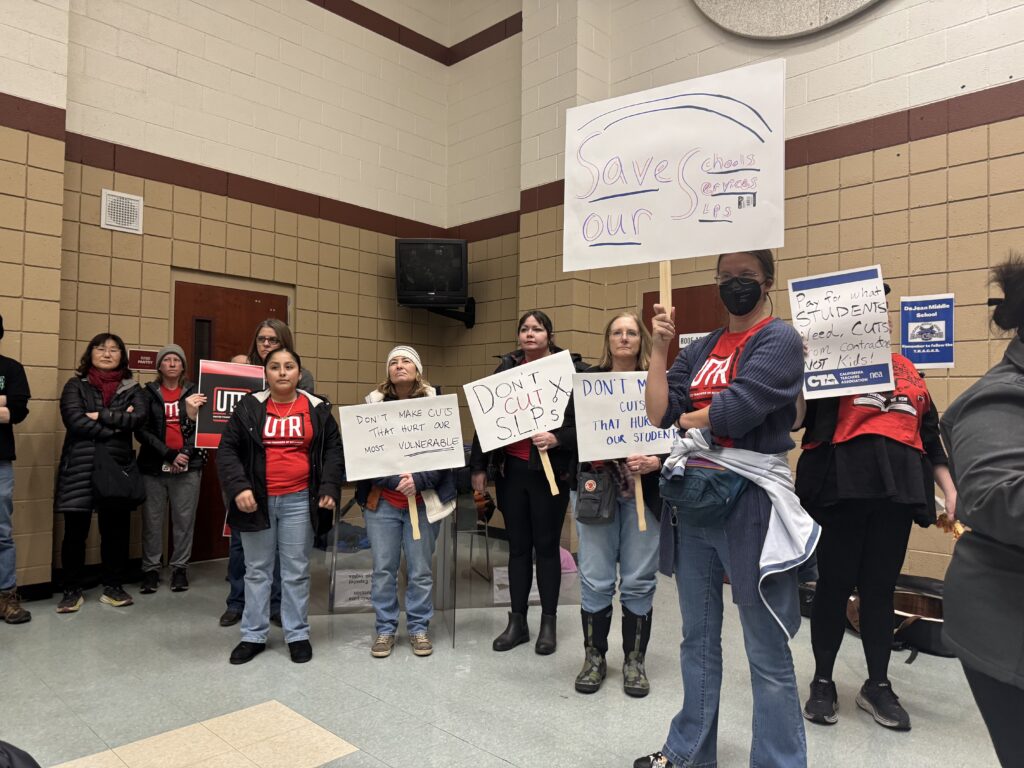
During small group reading instruction, AmeriCorps member Valerie Caballero reminds third graders in Porterville Unified to use their fingers to follow along as they read a passage.
Lasherica Thornton/ EdSource
Twenty-three-year-old Valerie Caballero worked with seven third-graders, guiding numerous activities on decoding words, on Thursday at Roche Elementary in Portersville. In another small group of three students, teacher Shelly Noble focused on building reading comprehension. The rest of the class, also in small groups, read independently or completed literacy assignments online, until it was time for the groups to change stations – to go to Caballero or Noble.
Caballero is one of 85 community members trained as AmeriCorps volunteers to tutor and support over 2,000 students at 10 elementary schools in Porterville Unified.
The AmeriCorps program deployed her and others to third to fifth grade classrooms to provide students with additional time for reading and math intervention that they wouldn’t get elsewhere.
“Families rely on programs like AmeriCorps to give their child one-on-one support and attention that they need,” Caballero said.
Fifth grader Jizelle Alvarado, who has benefited from the AmeriCorps program since her third grade year, said volunteer Stephanie Rector has helped her read at a better pace and to multiply three-digit numbers. Without hesitation, the fifth grader said she and other students would still be struggling with reading and math if not for Rector’s daily support.
Last Friday, the program was one of many whose survival became uncertain because of the reduction of federal AmeriCorps grants by the Department of Government Efficiency, or DOGE, under the Trump administration.
Nearly $400 million in AmeriCorps funding was cut, jeopardizing more than 1,000 programs and the jobs of tens of thousands of employees, tutors, mentors and volunteers, the national volunteer service organization reported.
Attorney General Rob Bonta announced in a statement earlier this week that California has “taken action to hold the Trump Administration and DOGE accountable to the law.” Two dozen states, including California, filed a lawsuit Tuesday against the Trump administration for “dismantling AmeriCorps.”
Unless the lawsuit prevails, the AmeriCorps funding cuts – estimated at $60 million for educational, economic, environmental, health and disaster response services in the state – will impact 87 programs and over 5,600 positions, according to Cassandra González-Kester, communications manager for California Volunteers, the state service organization that receives most AmeriCorps grant funding and disperses it to schools, nonprofit organizations and other entities to address critical community needs.
“These cuts affect service members who responded to the LA Fires, the tutors and mentors for our young students, as well as those who care for seniors,” she said. “School districts and non-profit organizations throughout the state are already feeling these severe impacts.”
But the nearly 14,000-student Porterville Unified has decided to use its own funds to continue the program until May 30, the last day of school — something not all schools and organizations will be able to do, so many communities will be left without critical services.
Thousands of students receiving support through AmeriCorps may have those services upended or interrupted – if they haven’t already – by the sudden cancellation of grants by the Trump administration.
The cuts are hurting the most vulnerable: kids in need of reading and math intervention; students struggling with chronic absenteeism; families experiencing housing instability; and communities recovering from natural disasters. The end of services could exacerbate existing inequalities and worsen future prospects.
“If we aren’t able to continue this work (beyond this school year),” Warren said, “it’s going to leave a huge void, and our students are definitely going to feel the effects of that.”
People supporting their community
AmeriCorps, an independent agency of the U.S. government, supports volunteer and service efforts in California and across the country by providing opportunities for community members to meet local needs and address pressing issues, including academic support and intervention for students, youth mentoring as well as homelessness, food insecurity, health and other key areas in communities.
Due to the range of programs that AmeriCorps supports, thousands of families in California alone will lose services, if they haven’t already.
“We recognize the impact this has across all programs and staff, not just in our state but nationwide,” said Monica Ramirez, the executive director of First 5 Madera, which operates the Madera Family Resource Center in the Central San Joaquin Valley.
The Madera Family Resource Center, a comprehensive hub for families with children aged 0 to 5, is partially funded by federal AmeriCorps money. The center provides weekly playgroups, preschool readiness programs, developmental screenings and resource referrals to support early childhood development. After getting notice about the AmeriCorps funding cuts, which had, in part, made services possible, the resource center, which extends services to Chowchilla, Eastern Madera County, and the Madera Ranchos, closed its doors this week.
Porterville Unified’s ‘Building Communities, Changing Lives’ is largely funded by AmeriCorps. AmeriCorps awarded the district more than $1.6 million in federal funds and the district matched those funds with about $1.2 million this school year.
Most of that funding goes toward living stipends for AmeriCorps members, community members and college students who may be tutors, mentors or in other roles.
Covering the operating costs for 85 AmeriCorps members who provide 35 hours of weekly student intervention and support is approximately $210,000 for May, an expense the district likely won’t be able to foot without the AmeriCorps funds.
“I don’t see another way to move forward without the AmeriCorps funding,” Warren said.
State agencies, such as California Volunteers, are trying to fill the void for impacted groups, Fresno State College Corps director Mellissa Jessen-Hiser said. The state, she said, will fund the college corps members’ continued work at places such as the food bank, Poverello House, a homeless shelter in Fresno, and Fresno Unified schools for the rest of the semester.
The federal government has provided more than half of the funding for some of California’s AmeriCorps programming, with the agency’s members supporting 17,000 foster youth with education and employment, and tutoring or mentoring 73,833 students in 2023-24, according to California Volunteers.
Volunteers play a ‘vital role’ in student progress
Of the more than 2,000 students that Porterville Unified AmeriCorps members provide one-on-one and small-group instruction, tutoring and intervention to, 1,657 are in need of academic support, based on this year’s district assessments.
Members work with at least 25 students each day over 10 months of the school year; they focus on reading and literacy, helping struggling students get to grade level.
“It’s going to create a larger learning gap if they’re not receiving this extra support,” said Caballero, the tutor.
Based on mid-year data from this school year, 44% of students served by AmeriCorps members have improved by at least one proficiency level on their reading assessment, demonstrating meaningful academic progress, Warren, the program director, reported.
 Lasherica Thornton/ EdSource
Lasherica Thornton/ EdSource Lasherica Thornton/ EdSource
Lasherica Thornton/ EdSource Lasherica Thornton/ EdSource
Lasherica Thornton/ EdSourceAnd with an extra person in the classroom working alongside them, teachers gain the ability to focus on the academic struggles of students who need it most.
Without AmeriCorps, “we will not see the growth in reading and writing that we see because the majority (of the work) will be put on myself,” said Noble, the third grade teacher.
The AmeriCorps members also build meaningful connections with students, extending their support beyond academics and making students feel valued, thereby creating an engaging and supportive learning environment.
“We’re able to really see the effects of having those members work with those students and the impacts that they’re making,” Warren said.
Federal funding cuts trickle down to schools
The California Reading Corps and Math Corps, or Ampact Educational Programs, across Fresno, San Mateo, San Joaquin, Merced, Tulare, Santa Barbara and Riverside counties have supported thousands of students with academic intervention, including over 6,000 students last school year. AmeriCorps members prepare students for kindergarten, get elementary students on track to grade-level proficiency by third grade and have seventh graders algebra-ready by eighth grade, according to program information for this school year. Its more than $3.1 million in federal funding is one of California’s 87 impacted programs.
Thomas Elementary in Fresno Unified, which has used the AmeriCorps reading support program, doesn’t plan to use the Reading Corps next school year due to the possible federal cuts, the district confirmed.
Under the 30-year-old Kern Community Mentoring program, three dozen AmeriCorps members have mentored over 700 high-needs students in the urban and rural communities of Kern County each year, according to Robert Meszaros, communications director with the Kern County Superintendent of Schools that administers the program.
By providing encouragement, guidance and support, they address the “whole child”, a philosophy that is evident in several AmeriCorps programs, specifically those focused on mentorship.
Each year, mentors help at least 20 students improve their academics, attendance, behavior and engagement, and based on data from the program, more than half of the mentees improve their attendance and reduce suspensions.
With the cuts to AmeriCorps, Meszaros said, it may mean the loss of the program.
Alternative funding, other options
Programs impacted by the federal funding cuts are exploring options to continue serving the community. Some are seeking support from their state representatives, who can advocate on their behalf at the state and possibly national level.
“Not sure what the next steps are,” Warren said. Porterville Unified is looking for alternative funding sources, such as state grants.
So is the Kern County education office for the AmeriCorps mentoring program it runs.
“Ultimately if that funding can’t be sourced from other resources,” Warren said, ”then it goes away and we’re left with a big void.”
While it’s unclear at the moment whether the multimillion-dollar cuts will stand, the people working in AmeriCorps programs urged decision-makers to realize the people affected.
In the words of Caballero, the Porterville Unified tutor: “think about students’ needs.”


